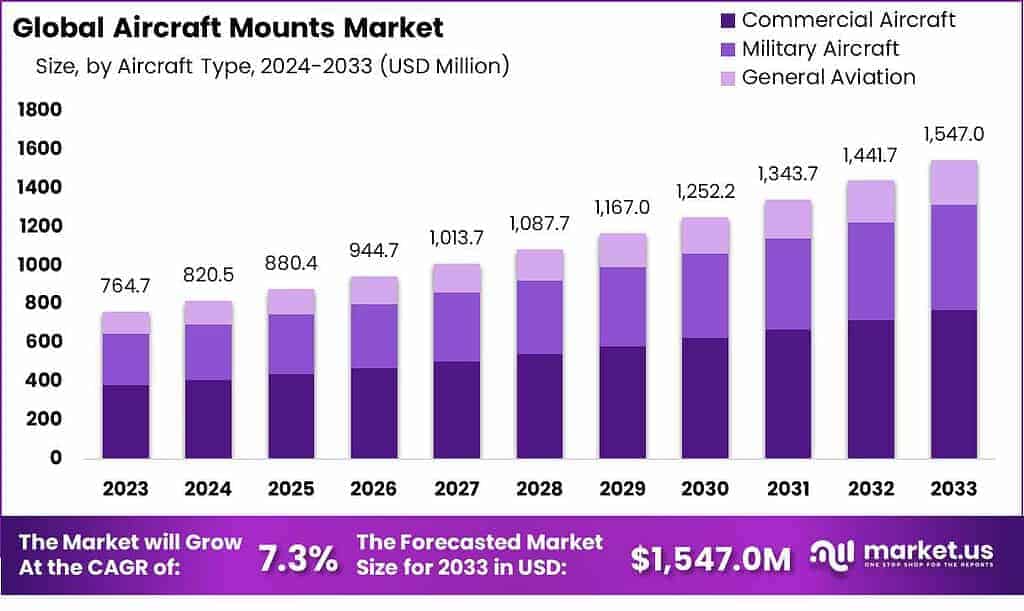Table of Contents
The global aircraft mounts market is projected to grow from USD 764.7 million in 2023 to USD 1,547.0 million by 2033, registering a CAGR of 7.3% during the forecast period. This steady growth is driven by increased demand for advanced aircraft systems, rising global air traffic, and modernization of military and commercial fleets. Innovations in lightweight and durable mount materials, coupled with enhanced safety and vibration control features, are propelling the market forward across various aviation segments.

How Tariffs Are Impacting the Economy
U.S. tariffs on imported aerospace components and raw materials have significant economic effects on the aircraft mounts market and related industries. These tariffs increase production costs for manufacturers by raising prices on metals, composites, and precision parts essential for aircraft mounts. According to Yale Budget Lab, tariffs have contributed to a 1.7% increase in consumer prices and reduced real household income by roughly $1,200 annually.
➤ Discover how our research uncovers business opportunities @ https://market.us/report/aircraft-mounts-market/free-sample/
(Use corporate mail ID for quicker response)
The tariffs disrupt supply chains, compelling companies to seek alternative suppliers or increase domestic manufacturing, which elevates operational expenses and delivery times. Trade policy uncertainty hinders investment in aerospace innovation and infrastructure, potentially slowing growth in aircraft manufacturing and related markets, including aircraft mounts.
Impact on Global Businesses
Rising Costs & Supply Chain Shifts
Manufacturers of aircraft mounts face higher component and material costs due to tariffs, prompting diversification of supply chains and localization efforts. These changes increase complexity and short-term expenses.
Sector-Specific Impacts
- Commercial Aviation: Elevated production costs may delay fleet upgrades.
- Defense: Tariff-driven price increases impact procurement budgets.
- OEMs & Suppliers: Supply chain disruptions affect production schedules.
- Maintenance & Repair: Increased parts costs influence operational expenses.
➤ Get full access now @ https://market.us/purchase-report/?report_id=74457
Strategies for Businesses
Businesses respond by diversifying supplier networks, investing in domestic manufacturing, and adopting lean production techniques to reduce waste and optimize costs. Collaborating with policymakers and forming strategic partnerships help navigate trade uncertainties. Flexible pricing and long-term contracts assist in managing financial risks.
Take advantage of our unbeatable offer - buy now!

Key Takeaways
- Tariffs raise material and component costs.
- Supply chain diversification is critical for risk mitigation.
- Sector impacts vary but affect production timelines.
- Operational efficiency and policy engagement are essential.
Analyst Viewpoint
Despite tariff-related challenges, the aircraft mounts market’s growth remains steady due to increasing aviation demand and technological advancements. Companies agile in supply chain management and cost optimization will outperform. Stabilizing trade policies will accelerate innovation and market expansion globally.
Regional Analysis
North America leads the aircraft mounts market due to strong aerospace manufacturing infrastructure and defense spending. Europe follows with active fleet modernization programs. Asia-Pacific exhibits rapid growth driven by increasing commercial air traffic and military investments. Emerging regions show potential despite infrastructural and economic challenges.
Business Opportunities
Opportunities exist in developing lightweight, corrosion-resistant mounts, integration of smart sensors for predictive maintenance, and expanding aftermarket services. Collaborations with OEMs for customized solutions and entry into emerging markets through partnerships offer growth potential.
Key Segmentation
- By Product Type: Engine mounts, equipment mounts, avionics mounts, structural mounts.
- By Material: Metals, composites, polymers.
- By End User: Commercial aviation, military aviation, general aviation, maintenance & repair.
- By Region: North America, Europe, Asia-Pacific, Latin America, Middle East & Africa.
Key Player Analysis
Leading players focus on R&D in advanced materials and vibration control technologies. Strategic alliances with OEMs and defense agencies expand market reach. Emphasis on quality assurance, certification, and compliance strengthens competitive positioning.
Recent Developments
Recent developments include introduction of lighter composite mounts, enhanced vibration dampening technologies, and increased investment in smart mount systems for real-time health monitoring.
Conclusion
The aircraft mounts market is poised for steady growth amid tariff challenges. Strategic supply chain management, innovation in materials, and strong policy collaboration will enable companies to capitalize on expanding aerospace demand.
Discuss your needs with our analyst
Please share your requirements with more details so our analyst can check if they can solve your problem(s)



